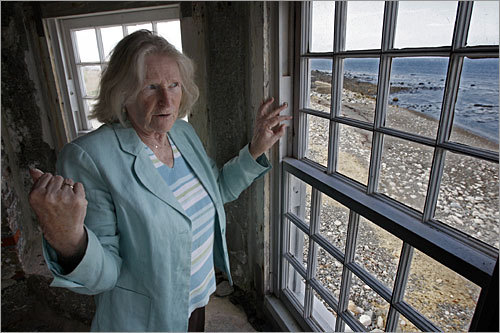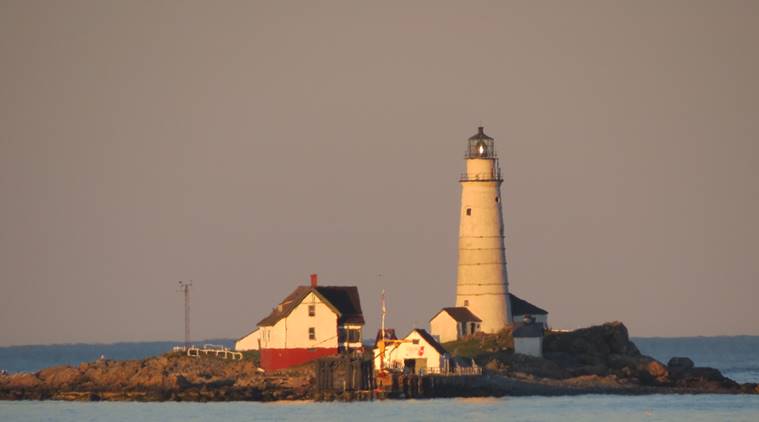

During World War II the light was extinguished for security purposes, but was relit in July 1945.

The light tower was raised to its current height of 98 feet in 1856. It was during this battle that American Captain James Lawrence famously said, “Don’t give up the ship.” US #936 – It’s the only lighthouse still actively staffed by the US Coast Guard.

During the War of 1812, the light’s keeper, Jonathan Bruce, witnessed the 1813 battle between the USS Chesapeake and the HMS Shannon. The light was transferred to the federal government in 1790. The Boston Light sat in ruins until 1783 when the commonwealth of Massachusetts rebuilt it in a similar style, though the new building stood 75 feet tall.

As a result, the British opted to destroy the lighthouse with explosives when they departed Boston in June 1776. The British attempted to rebuild the lighthouse, but colonial troops once again intervened. In July 1775, colonial troops set fire to the lighthouse to prevent the British from using it. US #1480-83 – After the Boston Tea Party, the British blockaded Boston Harbor and British troops took over control of the lighthouse.ĭuring the American Revolutionary War, British forces took control of the lighthouse in 1774. The light’s third keeper, John Hays, fared better during his tenure and requested a fog cannon that was installed in 1719 and remained in service for 132 years. Robert Saunders, the light’s second keeper, drowned just a few days after taking up his post. Franklin took his brother’s advice and wrote “The Lighthouse Tragedy,” which he then sold on the streets of Boston. As daughter Ann (who had stayed at home) waited on shore, the canoe capsized, and she watched horrified as her entire family drowned.īenjamin Franklin, who was 12 years old at the time of the tragedy, was reportedly urged by his brother to write about the unfortunate disaster. Shadwell paddled out to the ship in a canoe to pick up the family. The sloop carrying the Worthylakes anchored offshore at the lighthouse just a few minutes after noon. On November 3, 1718, Worthylake sailed to Boston to receive his pay, and then stopped at Lovell Island to pick up his wife and daughter Ruth. US #182 – A 12-year-old Ben Franklin wrote the poem, “The Lighthouse Tragedy,” after light’s keeper and family drowned. In addition, the light keeper kept a farm on Lovell’s Island, a flock of sheep on Great Brewster Island, and worked as a harbor pilot. He was paid 50 British pounds per year to keep the Boston Light glowing, and his pay was raised to 75 pounds in 1717. Worthylake lit the Boston Light for the first time on the evening of Septem(some sources say it may have been the 15 th or 16 th). The family also brought with them a slave named Shadwell. As was normal, Worthylake moved into the lighthouse with his wife Ann and daughters Ruth and Ann. George Worthylake, the light’s first keeper was raised on George’s Island in Boston Harbor. Completed in 1716, the lighthouse on Little Brewster Island was made of stone and stood about 60 feet tall. Smaller fishing boats paid a yearly fee of five shillings (a shilling was equal to approximately 12 pennies). The government approved the petition and placed a tax of one penny per ton on ships entering and leaving the harbor. Then in 1715, the people of Boston petitioned Massachusetts’s colonial government to build a lighthouse in the harbor. However, the harbor was still tough to navigate, filled with rocks and shoals that destroyed many boats over the years. In honor of its long history, it’s the only lighthouse in America to still have a light keeper today.ĭecades before the light was built, people lit bonfires on a nearby hill to guide ships approaching Boston harbor. On September 14, 1716, the first lighthouse in what would become America was lit for the first time in Boston Harbor. US #4793 from the New England Coastal Lighthouses issue.


 0 kommentar(er)
0 kommentar(er)
